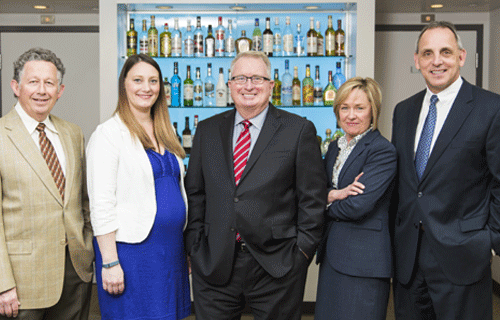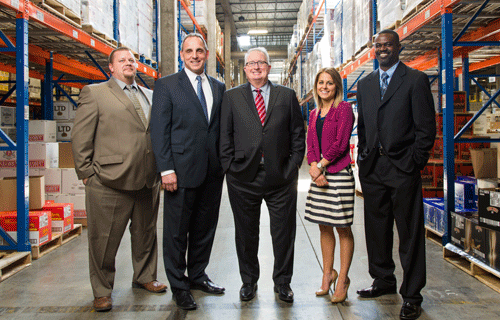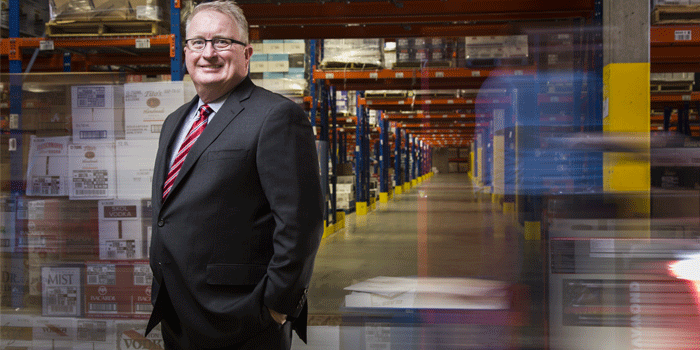Collaboration creates opportunity. That’s the philosophy Stephen Larson has abided by during his five-year tenure as the Administrator of the Iowa Alcoholic Beverage Division (ABD). He’ll carry that same motto with him when he assumes the position of chairman of the National Alcohol Beverage Control Association (NABCA) this spring.
“We need to step up the overall effort to engage with our stakeholders and deal with issues regarding how we do business as a wholesaler of spirits, matters of public policy regarding trade practices and refreshing our laws to reflect today’s marketplace,” Larson says. “That’s what we’ve been doing in Iowa by being more engaged with industry and the people we regulate.”
Changing the landscape in Iowa
Larson brings a unique perspective to the NABCA and to the industry in general. Although he’s spent his life working in public service, Larson began his career as an unclaimed property auditor for the State Treasurer of Iowa. Eventually becoming the state’s Deputy Treasurer, he has served on numerous boards and commissions, focusing on providing service to constituents. With more than 30 years of experience working in state government, Larson’s impressive knowledge of regulation and finance led to his appointment as Administrator of the Iowa ABD in May 2010 by then-governor Chet Culver.
One of the main challenges Larson faced in his role was the need to learn about the alcohol beverage industry from the ground up, understanding how Iowa’s business model works and grasping the concept of a state being in the distribution business. Although Iowa hasn’t owned any retail stores in 25 years, Larson had to familiarize himself with the relationships the agency has with retailers, licensees, vendors and the community. He also had to step back and analyze the makeup of the agency itself. The Iowa ABD employs a total of 77 agency staff members who serve in a variety of capacities, requiring Larson to examine the organization structure from multiple perspectives.
“We are ultimately here to regulate and generate revenue to help offset the cost of government,” Larson explains. “The other side to that is, you have so many different skill sets at play here, and everyone is working from a different point of view. We employ everyone from truck drivers to financial analysts. Each area of the agency needed to be examined in order to create a comprehensive improvement plan.”
Charged with improving the agency’s overall efficiencies and increasing transparency throughout the organization, Larson led the development of a five-year strategic plan devoted to operational and regulatory improvements. The initial phase of the plan launched in spring 2011 and has continued evolving over the past four years.
One of the major components of the improvement plan was a $6.5 million capital expenditure to upgrade the agency’s facilities, focusing on the areas of safety and efficiency. New racking and retrieval technology has already been implemented in the warehouse, resulting in immediate improvements in productivity and efficiency. The new racking system also gave Iowa the ability to offer additional products due to maximizing existing storage space. A new sprinkler system was installed, making the warehouse compliant with current state fire codes. The warehouse’s lighting system received a technology upgrade, aligning with the state’s other sustainability initiatives.
Additional improvements included replacing the HVAC system in administrative office areas, installing a new fiber optic network and making several improvements to the facility’s grounds, such as adding a new parking lot and truck turn-around area.
Another goal of Larson’s is to complete implementation of a single platform system, which will consolidate all of the agency’s existing computer programs into one seamlessly integrated database, eventually transitioning to a near-paperless operation. The Iowa ABD partnered with a fellow state agency and enlisted in the support of external vendors to create the path to develop and implement a new system and the program connected to this system. An educational and training component is also being developed in order to assist new users in taking full advantage of the system’s many features.
“We talk so much about the importance of technology in the workplace and the need to create these tools, but we also need to make sure we have the digital expertise needed to take advantage of them,” Larson says. He is currently working to develop a comprehensive training program that will help agency employees and their partners learn how to best utilize the electronic highway.
Ultimately, the development of the single platform system will allow the agency and its partners to access information easily and make better business decisions based on the data they have at their disposal. Larson’s goal is for the system to be fully operational by July 2016, allowing for several months of testing and refinement.
Another innovative electronic feature the Iowa ABD already has up and running is an online web portal that allows retailers and vendors to place orders online, review product and data analysis, manage license renewals, and review any violations. More than 35 percent of customers are currently utilizing the service. Additional users will be able to convert to the new online system when their licenses are up for renewal. As there are currently just over 1,300 licensed liquor retailers located across the state, the conversion process is expected to take some time.
How have all these changes impacted the Iowa ABD’s bottom line? It’s too soon to tell. The agency experienced modest revenue growth in fiscal year 2014. Spirit sales of $263 million equated to a 3 percent increase over the previous year. Additional funds generated by excise taxes on wine and beer, along with license fees, translated into a return of $119 million to the general fund.
Larson reports that the changes he’s implemented in recent years have all demonstrated moderate progress, but cautions that it’s still too early to give accurate projections of how much these many changes have ultimately benefited the state. He predicts that the total value of the investment, which is expected to greatly streamline efficiencies across the agency, will become apparent two to three years down the road.
The Iowa ABD plans to bring in an external consultant to collaborate on the development of a comprehensive report detailing how warehouse and delivery operations have improved in the past five years, and explore what other efficiencies can still be enhanced. This report, which will be presented to the governor and legislature in 2016, will serve as a guide in the development of a new five-year strategic plan for the agency which will likely focus on market changes, emerging technologies, trade practices and public policy issues.
Although the report detailing the results of his efforts won’t be released for some time, the effect Larson has had on Iowa seems to be viewed as an overwhelmingly positive one. He was reappointed to his post in 2014 by the state’s current governor, Terry Branstad, who is affiliated with a different political party than his predecessor. This signals that the agency is on the right track in providing service with value to its customers and the citizens of Iowa.
“For the past four years, we’ve been bringing in capital and zeroing in on how to improve our operations,” Larson says. “Now it’s time to step back and focus on the public policy side, which is something everyone has a common interest in.”

Leading the NABCA
In addition to his responsibilities in Iowa, Larson will assume the position of NABCA Chairman in May 2015. Believing that one of the primary roles of the association is to bring policy-makers together with industry partners, Larson is committed to steering people toward getting together to solve issues, improve communication and work to identify issues on which all interests can work together.
James Sgueo, President and CEO of the NABCA, thinks that Larson will add a great deal of value to the association in his new leadership role.
“Steve’s very open to being engaged with our partners beyond the norm,” he says. “His government background helps him understand the need of shared best practices and collaborative efforts. He’s very adept at working with others to improve efficiencies all around.”
Larson will continue to build upon the successful tenure of outgoing Chairman Jeff Anderson, who also serves as Director of the Idaho State Liquor Division (ISLD). Anderson spent the past year at NABCA’s helm stressing the importance of caring for the customer, which is also a main priority for him in Idaho.
“The end goal is always that we serve our customers well at the end of the day,” Anderson says. “For those of us that have retail operations in our states, caring for our customers is using sound business principles in terms of deciding which products to bring in, and helping to create a shop environment that meets the needs of today’s consumer.”
Focusing on re-engaging with NABCA customers over the past year, Anderson spent much time visiting with suppliers, addressing business concerns and identifying areas of mutual interest. Anderson also stresses that consumer needs don’t just stop with retailers and licensees: states have a responsibility to meet the needs of their suppliers, landlords of store locations and other vendors.
“We’re responsible for overseeing the 360-degree circle of the value chain,” Anderson states. “Everyone is a customer.”
Larson plans to pick up where Anderson left off with his theme of “collaboration creates opportunity.” His goal is to continue the personal meetings Anderson facilitated with industry partners, working together to maintain the integrity of the three-tier system. Larson also wants to focus on doing a better job of telling the NABCA’s story and encouraging the control states to provide as much information about future changes to their policies, procedures and regulatory positions as soon as possible in order to effectively share information within the industry.
Hopeful about the possibilities that the next year has in store for the NABCA, Larson credits Anderson with building a strong foundation.
“I’ve been fortunate over the years to have the opportunity to work with Jeff, and I’m very excited about the other people I will be involved with over the next year. They’re all very good at what they do,” Larson says. “I’m confident that our industry partners will be open to working with us as well.”

Teeing it up: Larson’s tips for success on the golf course and in the workplace
If you can’t find Stephen Larson in his office at the Iowa Alcoholic Beverage Division (ABD), chances are you’ll spot him out on the golf course.
Larson first developed a love of the game at the age of 12, when he worked as a caddy in Burlington, Iowa. He eventually transitioned from caddy to golfer, learning many lessons about the game and discovering how to improve his performance on the course. Little did he know that so many of those lessons would also provide him with invaluable business advice.
In golf, the player is constantly weighing the balance of risk and reward. Should he try to loft a shot over a wooded area, or play it safe by keeping to the fairway and probably adding a stroke? The same can be said of a project at work. Should an executive direct a significant investment in new technology or wait until the price comes down? Stephen shares some of the tips he’s learned on the golf course, which can easily be applied to work in the control states or just about any other business situation.
- “There’s much more to be gained by staying on the fairway and out of the rough.”
- “Even the best miss shots on occasion. The important thing is to adjust so that it doesn’t happen again.”
- “Nothing can hurt your game more than becoming emotional and irrational.”
- “Nearly a lifetime of golf has taught me the importance of being calm in tough situations.”
- “You cannot overstate the importance of course management, fundamentals and mental sharpness.”
How will these life lessons relate to Larson’s role as the incoming chairman of the National Alcoholic Beverage Control Association (NABCA)?
“My guide with this organization, as with golf, is that we will move forward by knowing what is to be the truth,” Larson says. “My intention is to continue to ensure that the NABCA moves without affecting other changes that have been made that have resulted in other successes.”










